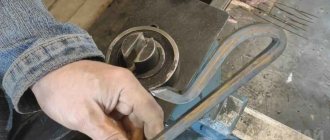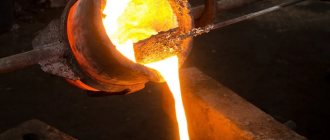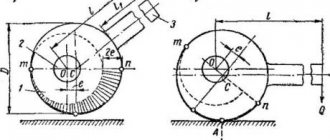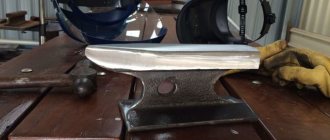Forged rose: It’s unusual, but nice to write a review about an item that will not bring you any practical use. There are many websites dedicated to welding and forging; these are popular “male” topics in RuNet. The craftsmen tell and show from the heart - some about forged chairs, others about welding seams.
But everyone has and makes their own forged roses; no one is alien to the desire for beauty and artistic creativity. Forged flowers can be made to suit every taste, but the preparation and technology for making them are the same. We read, we understand.
Preparation of materials and equipment
What materials will you need:
- Sheet metal is usually used for the petals and leaves The thickness and type of metal is a matter of taste and choice of the craftsman, but most often a sheet with an average thickness of 0.5 mm is taken. It can be cold-rolled black metal, or it can take metal from the hood or fenders of a car - it is quite thin there - up to 0.8 mm.
- For stems you need to find a suitable wire with a diameter of 5 mm or more; for options with spikes, a knitting wire with a diameter of 6 mm is more suitable - this work is more difficult. You can use rods with a diameter of 8 to 12 mm.
Forging process - drawing.
Hot forged metal roses.
Shaping the stem.
Making a flower.
The tools you will need are the simplest:
- Welding machine: better semi-automatic or inverter with 2 mm electrodes at a current of no more than 70 A.
- Grinder or grinder, metal scissors, pliers.
- Gas-burner.
- Drill with drill bits for metal from 0.5 to 1.0 cm.
- Unrefined or motor oil for finishing rose bluing.
- Metal paints, if the rose needs to be painted.
Making a rose from metal
Despite the fact that such flowers are called forged, you can make a rose from metal with your own hands without blacksmithing. Amateur-level welding skills are sufficient.
Materials and tools
Petals and leaves are made from sheet steel 0.3 - 0.8 mm thick or metal from the hoods and fenders of old cars. When choosing, you should take into account that thin iron has a high probability of burning through during welding, and thick material is more difficult to give the desired shape. The stem is made from reinforcing rod or knitting wire with a diameter of 8 - 12 mm. For finishing you will need unrefined or motor oil.
To create an iron rose with your own hands, you cannot do without the following tools:
- semi-automatic welding machine or inverter with electrodes with a diameter of 2 mm;
- grinder or grinder;
- metal scissors;
- electric drill with a set of drills with a diameter of up to 10 mm;
- gas burner or autogen;
- pliers and round nose pliers;
- felt-tip pen.
Making preparations for the future rose
A complex drawing is not needed for the work, since due to inaccuracies the flower will look more natural. If you plan to make a bouquet, prepare templates from thick paper or cardboard. To create an ordinary rose, 4 square blanks for petals with a side of 10 cm are cut out of a sheet of metal. To make the bud more magnificent, add another one. On one square there is a 4-pointed star in the form of a compass rose. This will be the sepal located under the flower. On the remaining squares, draw a schematic 4-petalled flower.
First, a drawing is made and petals are cut out of paper
For a lush metallic tea rose with many petals, the blanks are marked differently:
- the sepal is drawn in the form of a 5-pointed star in a circle with a diameter of 7 - 8 cm;
- on the first blank with a circumference of 11 - 12 cm, draw a flower with 5 petals;
- on the 2nd and 3rd with a diameter of 10 - 11 cm, 4 petals are placed;
- on the 4th circle with a diameter of 10 cm there will be 3 petals;
- on the 5th with a diameter of 9 cm, draw 4 narrow petals.
Metal blanks are cut
Mark 2 - 3 leaves of different sizes. Depending on the thickness of the metal, the blanks are cut with a grinder or scissors, without touching the central part. Notches are applied to the edges of the leaves.
Cutting without sewing, technical stages of work
The process of creating a rose:
Making a solid forged rose.
- From sheet metal we cut out four or five, if we want a larger rose, square templates with a side length of 10 cm. In each square we draw a schematic flower with four petals, try to draw them symmetrical, but precision to the millimeter is not needed here. On the last square we draw a sepal that looks like a compass rose; exact symmetry is not necessary here either.
- If you want to make a tea rose - wide open, with numerous petals, it is better not to be lazy and prepare the templates in the following order:
- The sepal is a five-pointed star with a diameter of 7–8 cm.
- The first outer blank consists of five petals with a diameter of 11 - 12 cm.
- The second and third blanks each have four petals with a diameter of 10–11 cm.
- The fourth blank is made of three petals with a diameter of 10 cm.
- The fifth is made of four narrow petals with a diameter of 9 cm.
- We cut out the blanks with metal scissors or, if available, with an angle grinder. We do not cut to the center of the figure.
- We draw on the metal a couple or three blanks for green leaves on the stem. The size must be different. We cut out the leaves with scissors or a grinder.
- Let's take the stem. If it is a rod, shorten it to 40 - 50 cm.
- We drill holes in the blanks to attach them to the stem. The diameters of the holes and the stem blank must match. The rod or wire should fit tightly into the petals.
- Welding stage: weld the workpieces to the stem. The optimal thickness of the electrode is 3 mm, the current strength is from 70 to 100 A. The holes in the petals do not have to be made round, the main thing is that the stem touches them with at least half of its circumference. In this case, the seam and the structure itself will be strong. You need to melt more rods than petals - it’s easy to burn through thin metal.
You need to plant the workpiece on the stem, starting with the sepals. The petals should be placed crosswise, two centimeters below the upper tip of the stem. Each layer must be secured by welding - similar to a puff pastry.
Table with roses.
Roses in a jug.
Metal structure with roses.
Bouquet of roses.
Forged rose.
Metal rose.
- Now comes the most exciting and artistic part of the work: forming the rose petals! We bend the leaves of the sepals of the lower workpiece down. Turn on the gas burner and begin to gradually heat the flat petals. At this stage, moderate heating is sufficient - there is no need to heat it red-hot. We use pliers to wrap the two petals as if we were wrapping them into each other. We wrap the remaining two petals around the first two. We work like this with each layer. At the same time, bend the tips of each petal outward - in the opposite direction. At this stage, it is important to have a “free” hand: the petals should be crooked, their bends in the opposite direction should be unequal, the serifs and marks should be asymmetrical. This is the only way the flower will turn out alive and real: there are no strict geometric shapes in nature.
- Let's start with the leaves on the stem. We make small notches on each edge of the leaves. The leaves should not be flat; it is enough to bend them with your hands. We weld it to the stem carefully at the weld points.
- In principle, the rose is ready. But only in principle!
https://www.youtube.com/watch?v=MbQ8wjkkzPw
Forging a rose from metal
To forge a rose from a single piece of iron, you will need a cylindrical blank with a diameter slightly smaller than the size of the future flower. After heating, one side of the blank from which the petals will be made is left unchanged, and the other is pulled into a square. Depending on the desired number of layers, the cylinder is divided into 3 - 4 parts. Circular notches are made along them of such a depth that in the center there remains metal in size equal to the square part. The resulting layers are deposited on the forming plate to a thickness of 2 mm.
Rose forging process
Then the production of petals begins. The undercuts on the layers are made in such a way that when folded into a bud they overlap. The resulting petals are riveted onto the pointed protrusion of the anvil, reducing the thickness towards the edges, and placed in a bud. The remaining layers are processed in the same way, but each subsequent one is made a little larger than the previous one. To make the forged rose more like a living flower, the petals of the bottom layer are made straighter. The collected bud is heated and the petals are given the desired shape using pliers.
After heating, a stem is forged from the square part of the rod. If desired, thickenings are made on the rod, from which spikes are formed. The leaves are cut out from sheet steel 2 mm thick. Cuttings are pulled from them and welded to the stem. To make the iron sheet look natural, veins are made on the surface.
The more improvisation when creating a rose from metal, the more original the flower turns out. It is recommended to experiment with the shape of the petals and their texture. However, it should be taken into account that the outer layer should not have more than 5 petals. Otherwise it will no longer be a rose.
Artistic floriculture: design stage
The fact that it is necessary to clean up welding marks and take measures to protect against corrosion is clear - it is not subject to discussion. But further design processing raises many questions. The fact is that blacksmiths and welding masters are happy to make metal roses and post videos with master classes and their photographs on the RuNet. Everyone has their own technical discoveries and style of execution - roses with buds, fully opened, with and without thorns - excellent tips and step-by-step guides, choose any.
But the finishing coat is simply a problem: our craftsmen only have enough imagination for bluing - treating the product with motor oil and then heating it until a varnish film forms. Varnishing or spraying is used less often. For some reason, our craftsmen talk about painting a forged rose with colored paints in a whisper and with fear - after all, artistic stereotypes are still strong.
Meanwhile, modern design fashion for eclecticism in all applied directions gives freedom and enormous possibilities in the color and texture design of metal flowers. But in any case, the forged rose will remain special and unique - the main flower of a huge army of blacksmith and welding masters. Join us and make your own rose.
How to make an iron rose
Cut 4 squares with a side of 10 cm from an iron sheet. If you want your rose to be more magnificent, prepare 5 squares.
Draw the shape of future petals on the squares, and on one of them - something like a “wind rose”. This will be a blank for the sepals, so don’t try to achieve perfect symmetry - nature makes each of its creations individual.
Next, cut out the petals of the iron rose with an angle grinder, without cutting to the very center, the cutting lines are shown in the photo.
Take an iron rod and, if necessary, shorten it to the required length - this is the stem of the future rose (40-50 cm).
Now you need to make holes for the stem in the cut out petal blanks. There are 2 methods - drilling and welding.
Drilling
Using a drill, drill a hole strictly in the center; the diameter of the hole should correspond to the diameter of the rod. If the diameters do not match, suppose you chose a rod with a diameter of 12 mm, and the thickest drill you have is 8 mm, then drill 3 holes side by side so that you get one hole of the desired size. Bend the inner edges with round nose pliers or thin pliers. The rod must fit tightly into the holes, otherwise it will be difficult to weld.











